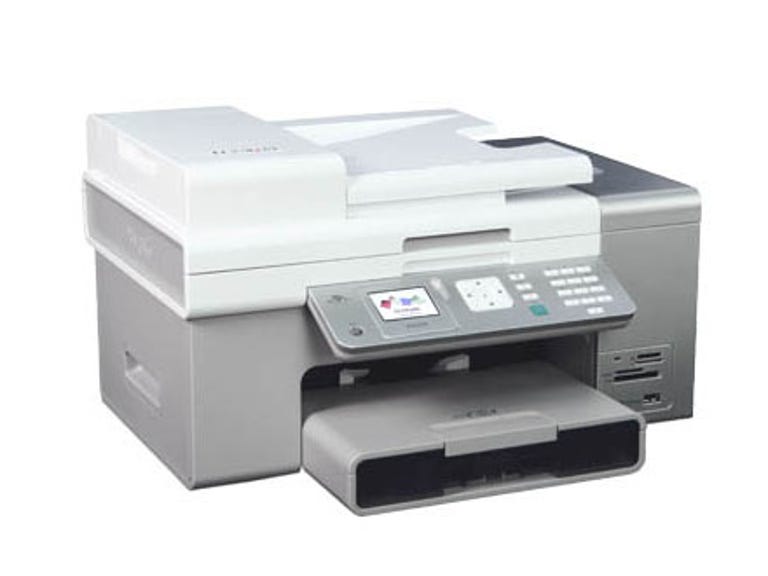 Why You Can Trust CNET
Why You Can Trust CNET Lexmark X9350 review: Lexmark X9350
The X9350 offers a good quality print experience, but the much lauded wireless printing ability really isn't that stunning.
Design
Lexmark's designers have obviously decided on a basic design motif for their recent printers. In trying to describe the X9350, we could think of no words more suitable than: "it looks like the X5470 with bits bolted on". And that's basically true; while the X9350 is less fussed about smooth white lines, and won't quite mesh with your iPod the way the X5470 does, they've both obviously fallen out of the same designer's grab-bag of tricks. Lexmark positions the X9350 as a SOHO multi-function device (MFD), so its design incorporates more business-centric features, such as a document feeder and inbuilt duplexing. The front panel has fax controls, basic copying buttons and a flip-up LCD screen for picture preview and menu selections, which sits above the main paper tray. And it's the paper tray that's the X9350's Achilles' heel. More on that shortly.
The Good
The Bad
The Bottom Line
Features
The X9350 is an inkjet MFD with either 4 (cyan, magenta, yellow and black) or 6 colour printing (via an optional photo printing cartridge) with integrated 4800dpi scanner and fax capabilities. Media slots on the front of the printer accommodate all the standard media card types -- CF, MMC/SD, MemoryStick and xD for direct photo printing -- as well as PictBridge support. The supplied paper tray can accommodate up to 150 sheets of standard paper, as well as a wide variety of other printable media, although it can't handle direct CD/DVD printing.
The X9350 can be connected via a standard USB cable -- Lexmark even provides one in the box -- or via Ethernet. As well, it supports wireless printing from Windows and Mac platforms, and it's this feature that Lexmark promotes heavily with this particular model. It even sports a natty little green display light to indicate that it's a wireless printer.
Performance
Setup of the X9350 -- beyond the tedious insertion of cartridges and unraveling of mysterious bits of tape that are part and parcel of any printer installation -- revolves around the supplied driver CD. We installed the X9350 across a network of Windows XP and OS X machines, although it's worth noting that the driver CD is Windows only, so there's a 19.8MB download before you can get started on OS X. The software not only installs the printer drivers, but also enables you to quickly and moderately-simply set up the printer's wireless functions. This approach is eminently preferable to the one employed by some other wireless gear we've sampled, which force you to use SMS-style data entry on the numeric keypad for configuration. The setup process also involves setting up a wireless scanning profile that'll automatically save scanned documents to a network-connected PC. We expected to hit all sorts of firewall permission problems with this, and were pleasantly surprised to find it a smooth and simple process.
The only spot that stumped us during the setup process was putting paper into the X9350. It'll support plenty of paper types, and even has guidelines for common paper sizes, such as 4x6-inch photo paper. What it doesn't support with the paper tray fully closed is A4. We're still scratching our heads to work out why. What makes it worse, though, is that the printer's quick start guide neglects to mention this fact; you've got to delve into the much thicker product manual to work this out. Nobody wants to spend a lot of time setting up a printer. Well, nobody sane anyway. It also took us some time to work out the optimal positioning for the paper tray, which juts out ever so slightly when loaded with A4, before we could reliably avoid paper jams.
Print quality and speed with the X9350 was acceptable but never spectacular and, predictably, it was a touch slower printing large files over the wireless network than when connected via USB or to a wired network. Photo quality was likewise good but not great, especially when using the 4-colour cartridge.
With an asking price of AU$499, the X9350 doesn't represent terrible value but within the SOHO sphere it's arguably a touch on the costlier side. Especially when you consider the raft of low-cost laser printers flooding the market. While the in-built wireless capability does offer some definite advantages in convenience, by allowing you to set the printer up anywhere you choose, the lower speeds achieved by this unit in wireless mode make this a less compelling feature than it might seem at first.


